#Akragas
Text
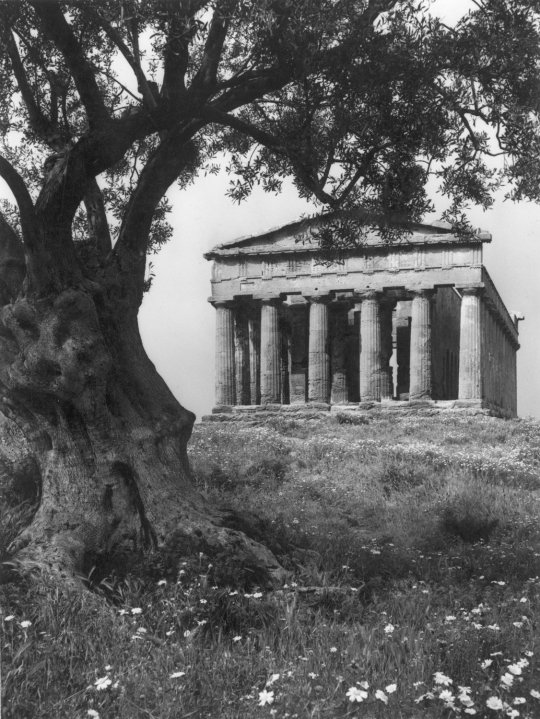
'Tempio della Concordia,' 1955,
Valley of the Temples, Agrigento, Sicily, Italy,
Photo by Konrad Helbig
#art#history#design#style#sculpture#antiquity#architecture#temple#vintage photography#sicily#italy#konrad helbig#concordia#agrigento#akragas
514 notes
·
View notes
Text
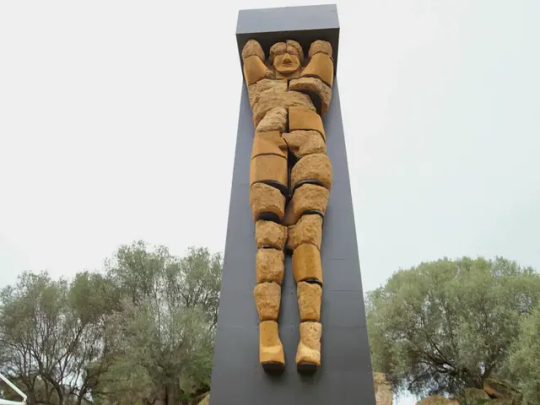
A Statue of Atlas Emerges From the Ruins of Sicily’s Ancient Temple of Zeus
In the fifth century B.C.E., 38 looming sculptures of the Titan stood guard at the structure.
After 20 years of restorations, a 26-foot-tall statue of Atlas is once again standing guard at the ancient Temple of Zeus in the city of Agrigento (once called Akragas) in Sicily.
The statue, created in the fifth century B.C.E., was one of roughly 38 similar Atlas monuments built into the temple. They stood in a line between columns with their arms raised, appearing to hold the holy structure upright.
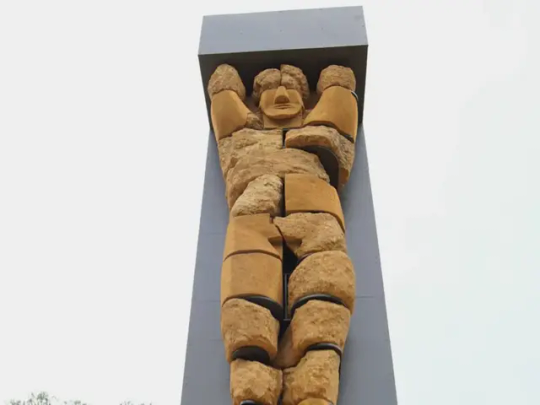
In Greek mythology, Atlas was a Titan who rebelled in a war against Zeus. As punishment, he was forced to hold up the sky on his shoulders. Unlike the mythological Atlas, however, the stone likenesses were unable to hold up Zeus’ temple forever. Ultimately, earthquakes and other events caused the structure to crumble.
For many years, pieces of the statues were scattered around the site amongst other ancient ruins. In 1812, Charles Robert Cockerell, a prominent British architect, first identified one of the Titan’s giant sandstone heads during a visit to Agrigento. A century later, in 1920, archaeologist Pirro Marconi became the first person to attempt to reconstruct one of the Atlases, which is now housed in the Archaeological Museum of Agrigento.
The seeds of the current project began in 2004, when the Valley of the Temples park conducted a sweeping research campaign at the site. Experts cataloged 90 fragments from at least eight Atlas statues.
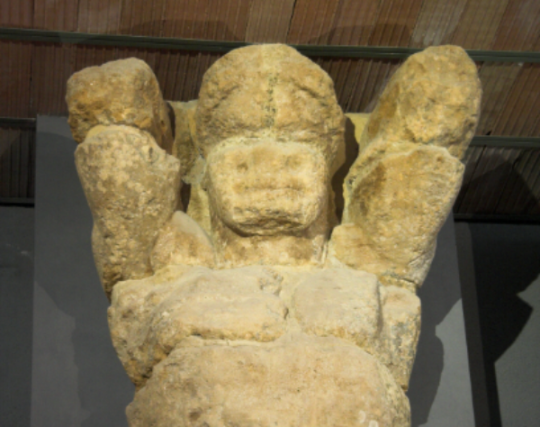
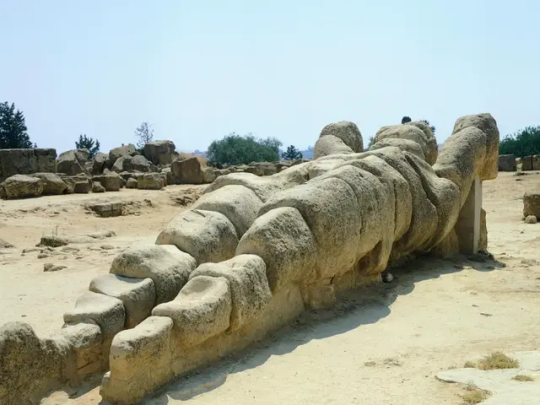

“The idea was to reposition one of these Atlases in front of the temple so that it may serve as a guardian of the structure dedicated to the father of the gods,” Roberto Sciarratta, the director of the Valley of the Temples park, tells the Guardian’s Lorenzo Tondo.
But rebuilding Atlas in a standing position was particularly challenging, as researchers couldn’t simply stack the pieces of the statue on top of one another. Instead, they attached the fragments to metal shelves, which are supported by a larger metal structure.
The restoration has faced scrutiny ever since officials first announced it several years ago.
“No archaeologist would endorse the use of ancient sculpture, no matter how fragmentary, to create a modern sculpture, even if the purpose is to highlight the site’s antiquity,” C. Brian Rose, an archaeologist at the University of Pennsylvania, told the New York Times’ Franz Lidz in 2020.
But officials like Renato Schifani, the Sicilian governor, think that the statue’s resurrection is a commendable feat.
“Today is an important day for Agrigento and for all of Sicily,” says Schifani in a statement, per Google Translate. “This stone giant of ancient Akragas, which after many years of studies and research we can observe in its natural position, is the heart of an important museum project of the entire area of the Temple of Zeus."
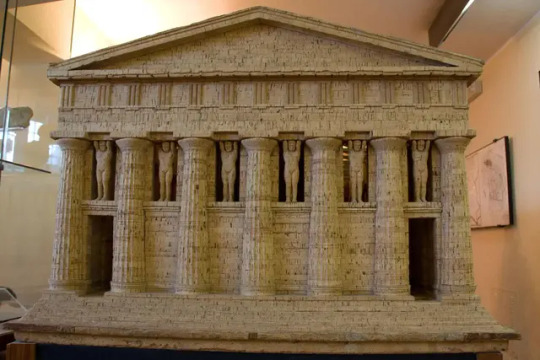
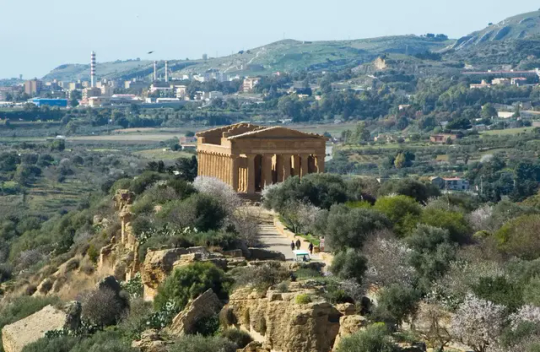
By Julia Binswanger.
#A Statue of Atlas Emerges From the Ruins of Sicily’s Ancient Temple of Zeus#Akragas#Agrigento#Sicily#Valley of the Temples park#temple#Temple of Zeus#ancient artifacts#archeology#archeolgst#history#history news#ancient history#ancient culture#ancient civilizations#roman history#roman empire#greek mythology
70 notes
·
View notes
Text
Nice find! The Aegean must be such a great place for diving.
11 notes
·
View notes
Text
RESTAURI / Il “gigante di pietra” dell’antica Akragas si è rialzato: svelato il telamone del tempio di Zeus [VIDEO]
RESTAURI / Il “gigante di pietra” dell’antica Akragas si è rialzato: svelato il telamone del tempio di Zeus [VIDEO]
Dopo vent‘anni di studi, ricerche e restauri il “gigante di pietra” dell’antica Akragas si è rialzato. Il “telamone”, una delle colossali statue antropomorfe che sostenevano l’architrave del tempio di Zeus Olimpio, l’Olympieion, simbolo della Valle dei Templi, è stato riportato in posizione eretta.
Stamattina la cerimonia di presentazione del telamone ricostruito con il presidente della Regione…

View On WordPress
0 notes
Link
Prima sparte della storia di Agrigento: illustriamo il periodo dalla fondazione di Akragas alla nascita del cristianesimo
0 notes
Text

#doge#ancient greece#Perilaus of Athens#Phalaris of Akragas#brazen bull#bull of Phalaris#le what do you mean test it out has arrived
73 notes
·
View notes
Text
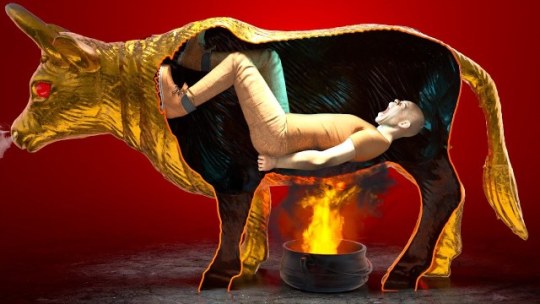
Brazen Bull — The Story of the Worst Punishment in History
The brazen bull was a torture and execution device designed and used in ancient Greece. The story goes that an inventor named Perilaus of Athens made the machine and presented it to the cruel ruler of Akragas, Phalaris. The bull was in the shape of an actual bull, of course, with a door through which the person to be tortured was put inside. A fire was set underneath the bull and through the acoustic apparatus inside the bull, the screams of the condemned were converted to the sound of an actual bull.
Although Phalaris himself was a tyrant, he was disgusted by Perilaus’s pride for his heinous invention. Therefore, he tricked him to get inside it himself and set it on fire. Ironically enough, the first victim of the bull was its creator itself. However, Phalaris did not kill him inside it and threw him off a cliff instead to finish him off. In a turn of fate, Phalaris himself was killed in the instrument when he was overthrown, and a century later, the instrument began to be connected to his name.
The Romans used a lot of instruments for the torture of Christians, most notable of which is crucifixion. However, they also put the bull to good (or bad) use. Saint Eustace was burned to a crisp in a brazen bull alongside his family by Emperor Hadrian. Saint Antipas, Bishop of Pergamon during the persecutions of Emperor Domitian met with a similar fate. He was roasted to death in a brazen bull in AD 92. Another victim was a Roman usurper named Burdunellus, who was roasted by Alaric the second in AD 497.
20 notes
·
View notes
Photo
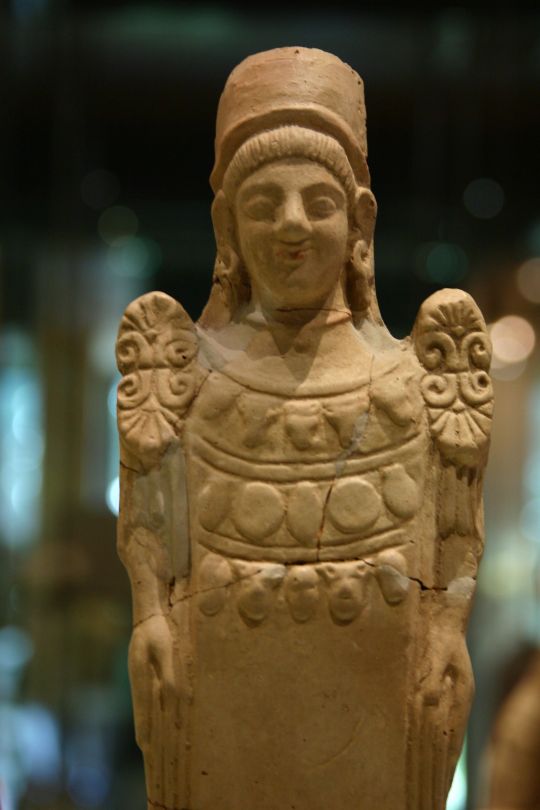
Demeter, terracota sculpture, Sanctuary of the Underworld Divinities, Akragas, Sicily, 550–500 BC
245 notes
·
View notes
Photo

Brazen Bull — The Story of the Worst Punishment in History
The brazen bull was a torture and execution device designed and used in ancient Greece. The story goes that an inventor named Perilaus of Athens made the machine and presented it to the cruel ruler of Akragas, Phalaris. The bull was in the shape of an actual bull, of course, with a door through which the person to be tortured was put inside. A fire was set underneath the bull and through the acoustic apparatus inside the bull, the screams of the condemned were converted to the sound of an actual bull.
Although Phalaris himself was a tyrant, he was disgusted by Perilaus’s pride for his heinous invention. Therefore, he tricked him to get inside it himself and set it on fire. Ironically enough, the first victim of the bull was its creator itself. However, Phalaris did not kill him inside it and threw him off a cliff instead to finish him off. In a turn of fate, Phalaris himself was killed in the instrument when he was overthrown, and a century later, the instrument began to be connected to his name.
The Romans used a lot of instruments for the torture of Christians, most notable of which is crucifixion. However, they also put the bull to good (or bad) use. Saint Eustace was burned to a crisp in a brazen bull alongside his family by Emperor Hadrian. Saint Antipas, Bishop of Pergamon during the persecutions of Emperor Domitian met with a similar fate. He was roasted to death in a brazen bull in AD 92. Another victim was a Roman usurper named Burdunellus, who was roasted by Alaric the second in AD 497.
47 notes
·
View notes
Text

Sicilian dancers, Italy, by Akragas Folk Dance Group
#sicilian#italy#europe#western europe#folk clothing#traditional clothing#traditional fashion#cultural clothing
100 notes
·
View notes
Text
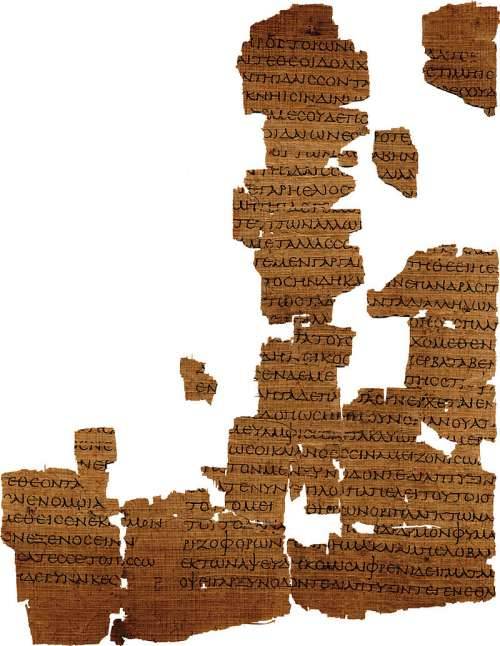
Below: Empedokles Fragment at the Bibliothèque Nationale et universitaire de Strasbourg
* * * *
Weak and narrow are the powers implanted in the limbs of men; many the woes that fall on them and blunt the edge of thought; short is the measure of the life in death through which they toil; then are they borne away, like smoke they vanish into air, and what they dream they know is but the little each has stumbled on in wandering about the world; yet boast they all that they have learned the whole—vain fools! For what that is, no eye has seen, no ear has heard, nor can it be conceived by the mind of man. You, then, since you have fallen to this place, shall know no more than human wisdom may attain.
But, gods avert the madness of those babblers of my tongue, and cause the stream of holy words to issue from my lips. And you, great muse of memory, maiden with the milk-white arms, I pray to you to teach me things that creatures of a day may hear.
—Empedokles (Ἐμπεδοκλῆς) of Akragas, Fragment on God (c 440 BCE)(following J.A. Symonds, Studies of the Greek Poets, ch vii (1920)).
[Robert Scott Horton]
7 notes
·
View notes
Text
did u guys know that the first bronze coins issued by Akragas (a greek colony in Sicily) weren't coins at all? they were shaped like teeth :)
4 notes
·
View notes
Photo

Silver didrachm with crab, c.500-490 BC
Minted in Akragas, Sicily.
#Silver didrachm with crab minted in Akragas Sicily c.500-490 BC.#archeology#archeolgst#coin#collectable coins#ancient coins#ancient artifacts#history#history news#ancient history#ancient culture#ancient civilizations
37 notes
·
View notes
Text
Kyo was the one who suggested the title of Dir en grey's next album, phalaris, and it is based specifically on the Phalaris bull torture device from Ancient Greece. He feels like the gap it has with the outside fits the image of the album.
Here is Wikipedia's description of the brazen bull:
"The brazen bull, also known as the bronze bull, Sicilian bull, or bull of Phalaris, was allegedly a torture and execution device designed in ancient Greece. According to Diodorus Sicilus, recounting the story in Bibliotheca historica, Perilaus (or Perillus) of Athens invented and proposed it to Phalaris, the tyrant of Akragas, Sicily, as a new means of executing criminals. The bull was said to be hollow and made entirely out of bronze with a door in one side. According to legends the brazen bull was designed in the form and size of an actual bull and had an acoustic apparatus that converted screams into the sound of a bull. The condemned were locked inside the device, and a fire was set under it, heating the metal until the person inside was roasted to death."

#very interesting#the idea that all that the outside world hears is pounding on bronze and a bull's bellowing#not sure what mechanism prevents the victim from pushing that door open though#Dir en grey#news#media#Phalaris#京#Kyo
68 notes
·
View notes
Text
Archeologia / Agrigento, recuperato in mare un “cavallo rampante” di marmo: faceva parte del fregio del Tempio di Zeus?
Archeologia / Agrigento, recuperato in mare un “cavallo rampante” di marmo: fa parte del fregio del Tempio di Zeus
Redazione
Importante recupero di un reperto archeologico nel mare di Agrigento: si tratta di un cavallo rampante, molto probabilmente un decoro frontale in marmo appartenente al celebre Tempio di Zeus Olimpo dell’antica Akragas ed elemento iconico nelle rappresentazioni artistiche del periodo greco.Il recupero, avvenuto nello specchio d’acqua antistante San Leone, poco distante dalla foce del…

View On WordPress
#Agrigento#Akragas#archeologia#archeologia subacquea#BCsicilia#Carabinieri#Carabinieri del Nucleo Tutela Patrimonio culturale#cavallo#fiume#Francesco Urso#Gaetano Lino#Gruppo Subacqueo#Messina#notizie#nucleo sommozzatori#Nucleo sommozzatori dell’Arma dei Carabinieri#Nucleo Tutela patrimonio culturale#Parco Archeologico#recupero#reperto archeologico#Salvatore Ferrara#San Leone#scavi archeologici#scoperte#Sicilia#Soprintendenza del Mare#subacquei#tempio#TPC#Valle dei Templi
0 notes
Text
After 20 years of restorations, a 26-foot-tall statue of Atlas is once again standing guard at the ancient Temple of Zeus in the city of Agrigento (once called Akragas) in Sicily.
The statue, created in the fifth century B.C.E., was one of roughly 38 similar Atlas monuments built into the temple. They stood in a line between columns with their arms raised, appearing to hold the holy structure upright.
In Greek mythology, Atlas was a Titan who rebelled in a war against Zeus. As punishment, he was forced to hold up the sky on his shoulders. Unlike the mythological Atlas, however, the stone likenesses were unable to hold up Zeus’ temple forever. Ultimately, earthquakes and other events caused the structure to crumble.

1 note
·
View note